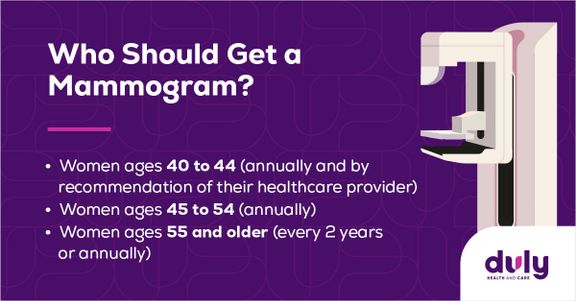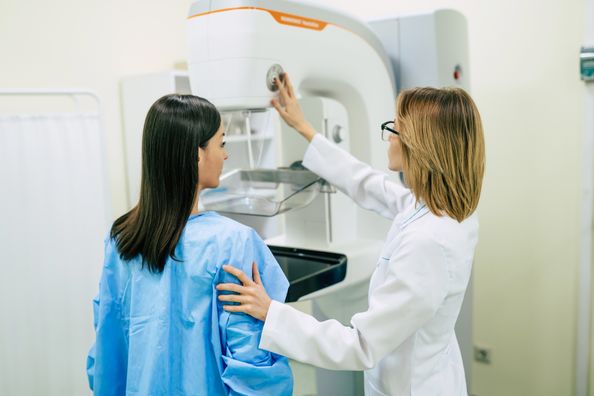Your first mammogram is a major milestone in taking care of your breast health. In the past few decades, mammograms have reduced breast cancer deaths by almost 40% — a promising figure for the most common cancer among women in the US, except skin cancers.
While mammograms are a lifesaving tool, they can also be overwhelming when it’s time for yours. You might be wondering how to prepare for a mammogram, what the experience will be like, and what happens when the appointment is over. Here are answers to 5 questions regarding preparing for your first mammogram.
1. When should I get my first mammogram?
Scheduling your first mammogram depends on your age and risk of developing breast cancer. In general, women can begin annual mammograms at age 40. Some women, such as those with a genetic mutation or a relative who was diagnosed with breast cancer at a young age, may be recommended to have earlier and more frequent screenings.

When it’s time to schedule your first mammogram, try to schedule it for a week after your menstrual cycle, when your breasts are likely to be less tender.
Ready to take charge of your breast health? Schedule your mammogram at Duly Health and Care today.
2. What happens during a mammogram?
A mammogram is a type of X‑ray that uses a machine that allows you to remain standing during the test. To start, a technologist will place one breast on a plastic plate. Then, they’ll adjust another plate to press from above, flattening the breast. By spreading the tissue apart, mammograms use less radiation and create a higher-quality image.
As the plates are pressed together, you’ll feel some pressure. The technologist will take the X‑ray picture and then repeat the process for a side view of the breast and the other breast. Each picture will take about 10 to 15 seconds, and the entire process will take about 15 to 20 minutes.
3. Do mammograms hurt?
Mammograms can be uncomfortable and, for some women, painful. Your experience will depend on the size of your breasts, how much they need to be pressed down, and the skill of the technologist performing the mammogram. You may also have more pain if you’re in the middle of or about to begin your menstrual cycle.
Fortunately, mammograms only take a few moments. Once it’s done, the discomfort is over. What’s more, mammograms can save your life, which is well worth a few minutes of pain.
4. What should (and shouldn’t) I wear for my appointment? Can I wear deodorant before my mammogram?
On the day of your mammogram, you’ll need to remove your clothes from the waist up. To make this easier, wear a separate top and bottom, and avoid dresses and other one-piece outfits.
Don’t wear deodorant, powder, or perfume to your mammogram appointment. These can show up on the X‑ray and make it harder for a radiologist to read your results. Some places offer special wipes to remove these products if you forget. If you’re not heading straight home after your appointment, you may want to bring your deodorant along with you to apply after your mammogram.
Finally, it’s best to leave necklaces at home and remove any nipple piercings before your appointment.
5. How soon will I get the results from my mammogram?
Your mammogram will be read by a radiologist, a healthcare professional trained in diagnosing diseases using medical imaging, including mammograms. Usually, you’ll get your results within a few weeks.
If your mammogram is normal, you can continue to get mammograms at the recommended intervals. By getting regular mammograms, radiologists can compare one picture to another to monitor for any concerning changes. This is why it’s also helpful to go to the same healthcare provider each time you get your mammogram.
If your mammogram is abnormal, don’t panic. Abnormal mammograms don’t always mean you have cancer. However, you will need additional tests, such as another mammogram, to determine the cause of the abnormalities.
Mammograms: A Key Piece of Your Breast Health
Regular mammograms are a crucial aspect of monitoring your breast health. It’s also important to prioritize your breast health in other ways, such as maintaining a healthy weight, exercising regularly, eating healthy, and limiting how much alcohol you drink. You should also become familiar with your breasts so that you can report any changes to your healthcare provider.
Managing your breast health is not a one-time concept. Instead, it requires an ongoing commitment to staying healthy, monitoring for changes, and keeping up with your mammograms.
Health Topics:


